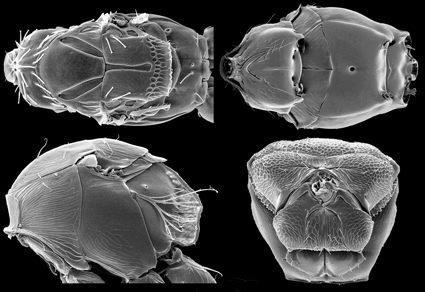Abstract
This is the second in a series of studies that aim to provide a comprehensive overview of the morphological diversity of Mymaridae (Hymenoptera) or fairyflies, a monophyletic family of small parasitic wasps postulated to be the sister group of all other Chalcidoidea. The external morphology of the mesosoma of about 65–75 taxa, representing 55–65% of the 115 currently valid described genera and subgenera, is described and illustrated with almost 269 scanning electron micrographs, including 77 micrographs of the dorsal, 71 micrographs of the lateral, 59 micrographs of the ventral, 53 micrographs of the anterior, and 9 micrographs of the posterior views of the mesosoma. Twenty annotated figures of the external and major internal structures are given. Two appendices list the morphological terms used, and names of the 75 genera and subgenera of Mymaridae illustrated. The variety of characters and their features that could be used to help define morphologically the genera, and possibly also the species, of Mymaridae is discussed.
References
- Bolte, K.B. (1997 [1996)] Techniques for obtaining scanning electron micrographs of minute arthropods. Proceedings of the Entomological Society of Ontario, 127, 67–87.
- Gibson, G.A.P. (1986) Evidence for monophyly and relationships of Chalcidoidea, Mymaridae, and Mymarommatidae (Hymenoptera: Terebrantes). The Canadian Entomologist, 118, 205‒240. https://doi.org/10.4039/Ent118205-3
- Goulet, H. & Huber, J.T. (Eds.) (1993) Hymenoptera of the world: an identification guide to families. Monograph No. 1894E. Agriculture Canada Research Branch, Ottawa, Ontario, 668 pp.
- Heraty, J.M., Burks, B.D., Cruaud, A., Gibson, G., Liljeblad, J., Munro, J., Rasplus,,J.-Y., Delvare, G., Janšta, P., Gumovsky, A.V., Huber, J.T., Woolley, J.B., Krogmann, L., Heydon, S., Polaszek,,A., Schmidt, S., Darling, D.C., Gates, M.W., Mottern, J.L., Murray, E., Dal Molin, A., Triapitsyn, S., Baur, H., Pinto, J.D., van Noort, S., George, J. & Yoder, M. (2013) A phylogenetic analysis of the megadiverse Chalcidoidea (Hymenoptera). Cladistics, 29, 466–542. https://doi.org/10.1111/cla.12006
- Huber, J.T. (2015) World reclassification of the Gonatocerus group of genera (Hymenoptera: Mymaridae). Zootaxa, 3967 (1), 1–184. https://doi.org/10.11646/zootaxa.3967.1.1
- Huber, J.T., Bolte, K. & Read, J.D. (2023) Mymaridae introduction, and head morphology as illustrated with scanning electron micrographs. Zootaxa, 5273 (1), 1‒100. https://doi.org/10.11646/zootaxa.5273.1.1
- Huber, J.T. & Thuróczy, C. (2018) Review of Anaphes Haliday (Hymenoptera: Mymaridae) with keys to European species and a world catalogue. Zootaxa, 4376 (1), 1–104. https://doi.org/10.11646/zootaxa.4376.1.1
- Krogmann, L. & Vilhelmsen, L. (2006) Phylogenetic implications of the mesosomal skeleton in Chalcidoidea (Hymenoptera, Apocrita)—tree searches in a jungle of homoplasy. Invertebrate systematics, 20, 615–674. https://doi.org/10.1071/IS06012
- Pinto, J.D. (1998) Systematics of the North American species of Trichogramma Westwood (Hymenoptera: Trichogrammatidae). Memoirs of the Entomological Society of Washington, 22, 287.
- Poinar, G. Jr. & Huber, J.T. (2011) A new genus of fossil Mymaridae (Hymenoptera) from Cretaceous amber and key to Cretaceous mymarid genera, ZooKeys, 130, 461–472. https://doi.org/10.3897/zookeys.130.1241
- Vilhelmsen, L., Mikó, I. & Krogmann, L. (2010) Beyond the wasp-waist: structural diversity and phylogenetic significance of the mesosoma in apocritan wasps (Insecta: Hymenoptera). Zoological Journal of the Linnean Society, 159, 22–194. https://doi.org/10.1111/j.1096-3642.2009.00576.x


